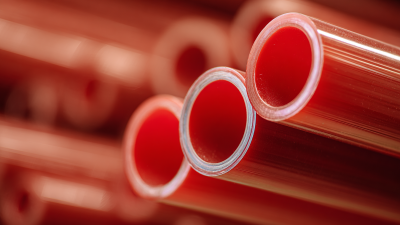Leave Your Message
In the rapidly evolving pharmaceutical industry, the choice of packaging materials can significantly impact product stability, patient safety, and overall market success. According to a recent report by MarketsandMarkets, the global pharmaceutical packaging market is projected to reach $ 1.02 trillion by 2024, growing at a CAGR of 7.2% from 2019 to 2024. Among the various packaging solutions, pharmaceutical tubes have gained popularity due to their versatility, ease of use, and effectiveness in protecting sensitive contents from environmental factors.
 As companies continually seek innovative alternatives to traditional packaging, understanding the specific needs of your drug formulation becomes crucial. This blog aims to guide you through the essential considerations in selecting the right pharmaceutical tube, ensuring it meets the unique requirements of your product while enhancing user experience and compliance.
As companies continually seek innovative alternatives to traditional packaging, understanding the specific needs of your drug formulation becomes crucial. This blog aims to guide you through the essential considerations in selecting the right pharmaceutical tube, ensuring it meets the unique requirements of your product while enhancing user experience and compliance.
When selecting the right pharmaceutical tube for drug packaging, it’s essential to understand the various options available in the market. Pharmaceutical tubes come in various materials, including plastic, aluminum, and laminate, each offering distinct benefits. For instance, plastic tubes provide flexibility and resistance to breakage, making them ideal for creams and ointments. Conversely, aluminum tubes offer superior barrier properties against moisture and light, preserving the potency of sensitive medications.
Moreover, the specific requirements of the drug formulation significantly influence the choice of packaging. Studies indicate that approximately 25% of pharmaceutical products are sensitive to light, highlighting the need for opaque containers to prevent degradation. Additionally, the compatibility of the tube material with the active pharmaceutical ingredient (API) cannot be overlooked. According to industry reports, almost 30% of packaging failures can be attributed to inadequate material selection, emphasizing the importance of a thorough evaluation. Therefore, when assessing pharmaceutical tubes, manufacturers must consider factors such as barrier properties, chemical compatibility, and compliance with regulatory standards to ensure product efficacy and safety.
When selecting pharmaceutical tubes for drug packaging, several key factors must be considered to ensure product integrity and safety. Firstly, the material of the tube plays a critical role. Common materials include plastic and aluminum, each offering unique benefits. Plastic tubes are lightweight and often more cost-effective, making them suitable for a range of products. On the other hand, aluminum tubes provide excellent barrier properties, protecting the contents from light and moisture, which is vital for sensitive medications.
Another important consideration is the tube's design and functionality. Features such as the seal type, closure mechanism, and ease of dispensing can significantly impact user experience. For instance, a flip-top cap may be more user-friendly for certain applications, while an air-tight seal ensures longer shelf life for the drug. Additionally, compatibility with various filling processes is crucial to maintain efficiency in production. By evaluating these factors meticulously, pharmaceutical companies can choose tubes that not only safeguard their products but also enhance customer satisfaction.
| Key Factors | Description | Importance Rating (1-5) |
|---|---|---|
| Material | The type of plastic or laminate used to ensure drug stability. | 5 |
| Barrier Properties | Resistance to moisture, light, and air to extend shelf life. | 5 |
| Size and Capacity | Volume of the tube, which should match the required dosage. | 4 |
| Compatibility | Ensure the tube material is compatible with the drug's formulation. | 5 |
| Regulatory Compliance | Must meet the local and international pharmaceutical regulations. | 5 |
| Cost | Overall cost-effectiveness considering quality and volume. | 4 |
| Environmental Impact | Sustainability and recyclability of the packaging materials. | 3 |
When it comes to drug packaging, the choice between plastic and glass is pivotal and can significantly impact product efficacy, safety, and consumer satisfaction. The global pharmaceutical plastic packaging market is projected to reach USD 681.33 billion by 2034, growing at a remarkable CAGR of 16.39%. This substantial growth underscores the increasing preference for plastic materials, primarily due to their lightweight nature, cost-effectiveness, and versatility in design. Innovations in plastic technology, combined with a focus on sustainability, have also led to the rise of bioplastics, like polylactic acid (PLA), which offer compostable options whilst fulfilling industry needs.

Conversely, glass packaging remains a critical player in the pharmaceutical sector, particularly for sensitive products requiring high stability and barrier properties. The glass packaging market for drugs is anticipated to grow from USD 5.51 billion in 2025 to USD 9.02 billion by 2035, highlighting its enduring relevance. Recent advancements in glass material testing and manufacturing methods are aimed at enhancing safety and efficacy, catering to the demands of increasingly stringent regulations. As companies evaluate their packaging options, balancing the benefits of plastic and glass will be key to meeting both regulatory standards and consumer expectations in the fast-evolving pharmaceutical landscape.
When choosing pharmaceutical tubes for drug packaging, understanding the importance of barrier properties is paramount. Recent studies have highlighted the significant differences in moisture and oxygen barrier properties among various materials such as glass, PET, and HDPE bottles. For instance, research indicates that glass offers superior moisture resistance, making it ideal for products sensitive to humidity, while PET and HDPE may provide adequate protection for other formulations. It's essential to assess the volume and diameter finishes, as these factors can further influence a tube's ability to shield its contents from environmental factors.

Additionally, breakthroughs in material science have led to advancements in antimicrobial coatings, which have shown promise in applications like endotracheal tubes. These coatings are crucial in preventing biofilm formation, which can result in ventilator-associated pneumonia (VAP). Understanding these technological developments can aid in selecting tubes that not only preserve drug integrity but also enhance patient safety by reducing infection risks. By aligning packaging choices with the specific barrier requirements of the drug, pharmaceutical companies can significantly improve the effectiveness and reliability of their products.
When it comes to pharmaceutical packaging, ensuring regulatory compliance is paramount for both safety and effectiveness. The intricacies involved in drug packaging require adherence to strict guidelines that not only protect the integrity of the medication but also safeguard patient health. From preventing contamination to ensuring proper labeling, stringent processes must be in place to comply with regulations. This is especially crucial for prefilled syringes and auto-injectors, where precision in delivery is essential.
Tip: When selecting packaging materials, prioritize those that not only meet regulatory requirements but also provide barriers to moisture, light, and temperature variations.
Moreover, smart packaging solutions are emerging as valuable tools in meeting these compliance challenges. These technologies can enhance traceability, combat counterfeiting, and ensure that patients receive the correct dosage.
Tip: Consider integrating digital tracking systems into your packaging process to streamline compliance and improve patient outcomes.
By focusing on these aspects, pharmaceutical companies can navigate the complexities of regulatory compliance while ensuring that their packaging solutions are safe and effective for drug delivery.






